By Jeffrey A. Rendall, Photos by Mike Tanner
ROANOKE, VA – “This one was just meant to be,” said Lester George in prefacing his remarks on the building of Ballyhack Golf Club, the latest of his mid-Atlantic golf architectural masterpieces in the southwestern part of Virginia.
That’s what all the golf architects say about the great ones – but after hearing George tell the story of how Ballyhack came into being, I became a believer. It’s a long story, but the hints to Ballyhack’s eventual destiny just kept coming back to George like clues in the National Treasure movies – and in the end, he was right… Ballyhack truly was meant to be.
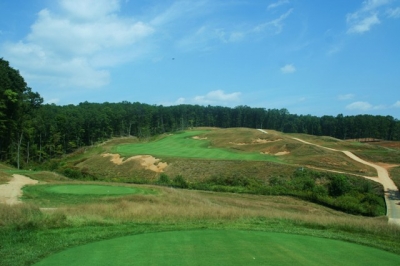 |
| Right from the start you'll get an idea of the nature of golf at Ballyhack - big targets, big hazards and big intimidation. Here, the view from the 1st tee. |
George starts the story at the beginning: “I happened on the Ballyhack site in 2002 (or it might have been 2003) by accident. I was working with the people who were putting together the First Tee program in Roanoke at the time, when one of the principals approached me and said ‘have you got a few extra minutes?’ – he had something he wanted to show me.”
A few extra minutes turned into a couple hours as the two of them drove out across the Blue Ridge Parkway to a farm about a mile outside of town on the southeastern side of Roanoke.
It didn’t take long for George to grasp the possibilities with the site – an open, rolling, dramatic piece of land bisected by a county road with long-range views of mountains and just enough trees to give it some contrast. George’s companion said, “I think if there’s ever another great golf course built in southwestern Virginia, this possibly could be it.”
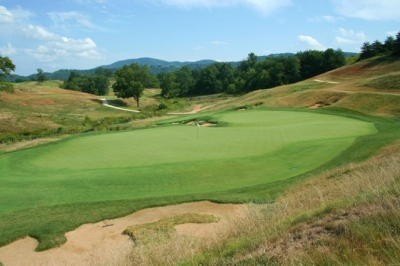 |
| All of Ballyhack's greens are large - but the 13th and 15th holes 'share' a putting surface that's large enough to set up a residence. |
The brief visit was enough to get George thinking about the farm, but it turns out the land wasn’t even for sale at the time – and the owner had resisted any and all attempts by the golfing locals to acquire it. For the next couple years, every time George was in the area he’d make a special point to drive out there and gaze at the possibilities – “I just kind of fell in love with the look,” he said.
Fast forward about three years, when everything changed one day in Richmond on a chance visit to a stranger. “I went to a guy’s house here in Richmond to check out his antique car collection,” George explained. “I’d never met the man (he had some wonderful cars, it turns out), and when he found out what I do for a living, he said ‘I’ve got the prettiest piece of land you’ve ever seen for a golf course in Roanoke.’”
George replied that because of his lengthy experiences there, he was already well versed on the land in Roanoke, and there wasn’t a site large enough to build a golf course in any case. The car owner then told him his plot was about a mile outside of town, and described a location remarkably similar to George’s dream site. George wrote down the address and about a month later, went out to investigate.
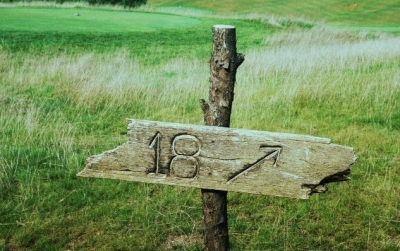 |
| Everything at Ballyhack contributes to its rustic flavor, including the directional signs. |
It was the same place. “It was kind of creepy how this kept coming up,” George remembered.
Even with the discovery, the Ballyhack odyssey was far from over, however. Upon calling the antique car collector to inquire as to his interest in selling the farm, George learned that the proposed Interstate 73 (which would run roughly from Chicago to Myrtle Beach) was slated to go right through the property – it would have occupied what is now the fifth fairway. The owner wondered aloud if it would be possible to build the course on the other half of the property that would be left untouched – but George said it wouldn’t work (due to spatial considerations).
One day later (as George recalls), he saw a headline in the Roanoke newspaper saying that the Interstate 73 project had been abandoned.
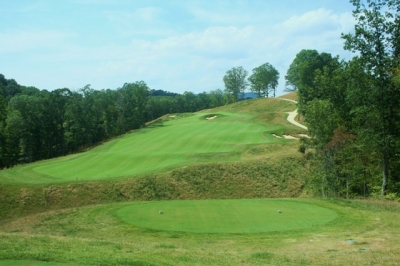 |
| The par four 11th hole is only 357-yards, but it's uphill and demands precise placement off the tee to leave a good angle into the green. |
This thing was proving to have more lives than Morris the Cat.
Excited at the news, George again called the property’s owner, who said he’d already received two full-price offers with no contingencies (yes, the same day as the news broke on the cancellation of the I-73 project), but said he’d be open to keeping George in the hunt if the golf course designer would send in a full-price contract on the land by the next day.
George did as requested, and then headed to New Orleans with his wife for a break from all the excitement. “I was on Bourbon Street, and the owner calls me and says, ‘I thought I told you I wanted a full-price contract.’ I told him that I’d given him what he asked for, and he replied that he’d gotten other offers that were above the asking price.”
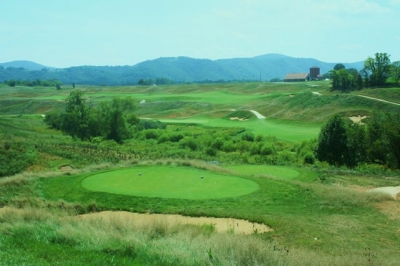 |
| The short (354-yards) par four 6th hole is one where you'd normally expect to make a birdie, but if you gamble and miss, a high number is definitely within reach. |
More than a little perturbed, George tersely said he wasn’t getting into that game and hung up the phone. “I looked at my wife and said, ‘you know that piece of property in Roanoke? We’re never going to get it now.’ Two hours later he called back and told me that he’d signed my contract, which provided me the ability to get zoning and financing – and we progressed fairly quickly from there.”
George said the locals went out of their way to help, aided partly by relief that the Interstate was no longer going through – but also from the fact that the property had also been looked at as a possible site for a landfill and sewage treatment facility.
For all the folks who think golf courses are a nuisance, there’s a lesson to be learned here: they make far better neighbors than trash dumps or smelly sewage treatment facilities.
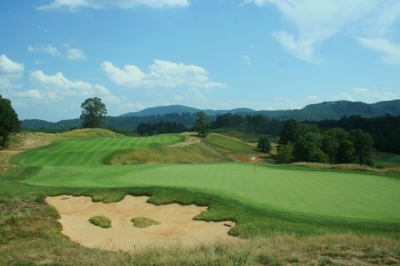 |
| From behind the green of the par four 12th hole, probably the most difficult in a set of very challenging par fours. |
There was one crucial piece of the puzzle that was yet to be resolved – who would partner with George to share in the ‘vision’ and build the course? In George’s mind, there could only be one man for the job. “Bill Kubly of Landscapes Unlimited had built Kinloch (near Richmond) for us, and ten other golf courses, so he was definitely the guy I wanted to build this – but I wasn’t even sure what the business plan was going to be, or a heck of a lot of the other details. I called Bill and told him that if he didn’t see what I see in it, then I was going to have to let it go.”
After about twenty minutes of walking the property, George said Kubly did ‘see’ it – and said if they could do it like he’d done at Sutton Bay (a highly rated club in South Dakota that Kubly had built), he’d do the work. “There again was another break – this thing was just meant to be,” George added.
Other partners were then enlisted – Balzer & Associates (a Roanoke engineering firm), Coach Frank Beamer of Virginia Tech and some ‘silent’ partners in addition. George even sought the counsel of former U.S. Amateur champion Vinny Giles (who co-designed Kinloch with George), though Giles had no design role at Ballyhack.
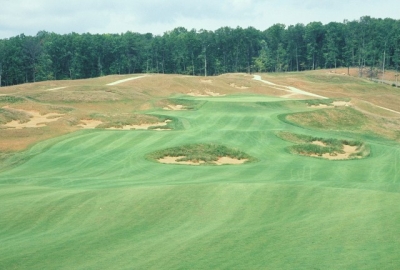 |
| The uphill par four 5th hole provides several options on where to place your tee shot - but the approach shot to a very tricky green is where the real tough part comes in. |
With the team complete, ground was broken in the fall of 2007 and the club opened in June of last year (2009). Like Sutton Bay, Ballyhack is a private national club, with fifty local and 250 national members.
Once George was successful in acquiring the land and assembling the ‘team’ to build the new golf club, there was yet another surprise in store – this time, the name ‘Ballyhack’ was just meant to be. Again, he explains: “We were originally going to name the club something else, but here again, the name Ballyhack just kind of ‘appeared’ to us.”
He continues, “Jonathan Ireland, our Director of Golf (who George had known through his employment at Kinloch Golf Club in the early 2000’s), was formerly at the nearby Roanoke Country Club prior to coming over here. He was at a function one night and a 92-year-old woman asked him where his new project was (because he’d announced that he was leaving the Roanoke Club) – and he told her. She said ‘oh, we used to call that area Ballyhack.’”
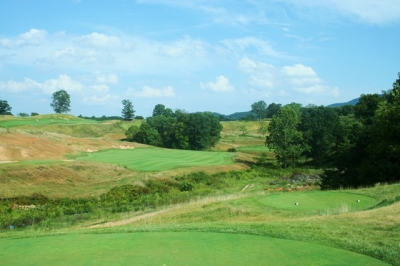 |
| Looking from the tee of the 491-yard par four 16th hole, which thankfully plays downwind most days. |
The team was looking for a name that sounded like it came from the Old Country, as they knew from the start that they wanted to build a links-type course. So they started doing research on the name Ballyhack, and found that sure enough, the area where the course was being constructed (just south of Mount Pleasant) was known by that name.
The evidence was plentiful -- there were newspaper clippings that mentioned Ballyhack; there’d been a school named Ballyhack; there was a police officer killed in the 30’s (on a raid of a still) in a place referenced as Ballyhack. There was even a Civil War battle of Ballyhack, as attributed to in a Union officer’s official battle report.
Indeed, the place did exist.
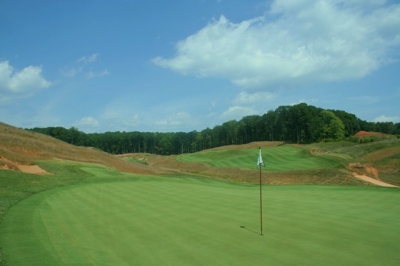 |
| Looking back from the green of the par four 4th hole. Rated Ballyhack's #1 handicap hole, it's a serious challenge from tee to green. |
The sealer was another bit of chance. “Early last year (2009), my wife and I were at an antique show, and we found a master plan done in 1928 for the City of Roanoke. It was a thick book with all kinds of panels in it, drawings and maps, etc. The very last drawing was a regional map, and right down where the farm was – was the word Ballyhack. And right beside the word Ballyhack was the word ‘Lester.’ We don’t know why – we don’t know if it was a landowner, or another regional name… it was really bizarre,” George remembered.
“We were just about to open the club when we saw that – and we were freaked out,” George said.
So it seems already, ‘Ballyhack’ is the stuff of legends, but the golf course itself will have to carry the rest of the legacy. Even here, that shouldn’t be a problem, as there truly isn’t anything quite like Ballyhack in this part of the world. The scale of the course alone reminded this writer of the Plantation Course at Kapalua (Maui, Hawaii) – with big everything: large fairways, enormous bunkers and huge greens. And while there isn’t the vast ocean to provide the scenic backdrop (as with the Plantation Course), there are plenty of ‘big’ views of the beautiful surrounding countryside at Ballyhack.
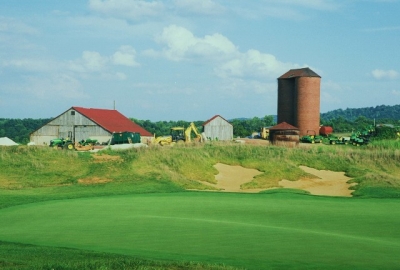 |
| Evidence of Ballyhack's farming past are there to remind you that it wasn't all that long ago that this place was a working farm. |
George said it couldn’t have been any other way. “The site dictated the type of course we built. It’s got so many long views and so many prominent elevations to stand on. Had we tried to put a ‘normal golf course’ on that land – the site would’ve dwarfed the course. There weren’t many trees – we only cleared forty acres – so we basically picked all the best terrain features to put the routing on.”
There was plenty of land to choose from – so why not build a ‘big’ course if you’ve got the room? There was even enough land to include home sites – seventy, along the perimeter of the course – but the layout itself is and will remain a ‘core’ golf course.
And because of the open nature of the property, the wind was another ‘big’ factor in the style of the links. “The mountain range that you see from many points on the property is called ‘windy gap,’” George explained. “It blows up there, and we knew when laying out the course that wind would be a huge factor in playing it. The greens and fairways had to be large to accommodate the conditions, and if the course is playing hard and fast, as it should be – then there was no other way to make it playable except to have everything built to scale.”
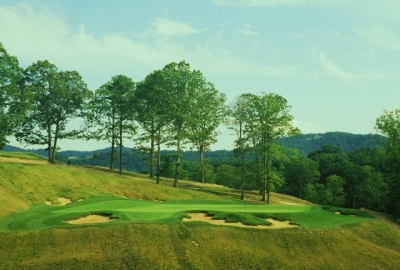 |
| The par three 17th hole is the shortest at Ballyhack - but if you're not on the right level of the green with your tee shot, you'll have a hard time making a par. |
The putting surfaces are indeed humungous – and in places, a bit dicey. There are several on the course that George said needed to be spiced up a bit – which includes some shelves and swales that would make the classic architects proud. The par three third hole’s green alone is 11,000 square feet, but it’s so sloped that there are only six cup positions on it.
Like all courses of this scale and quality, it will take several plays to learn the best way to navigate your way around. One of the prominent features you need to avoid are the bunkers – they’re huge, and in some cases steep. Even the bunker style has a story behind it, as Jonathan Ireland provides: “Lester George designed Ballyhack’s bunkers unlike any I’ve seen on the East Coast.”
Ireland continues, “Consistent with the natural feel of the design the bunkers appear to be true ‘blowouts,’ where wind and erosion created the gouges over years of exposure, even to the extent that he selected a medium-brown sand because white sand is not native to the Southwest Virginia region.”
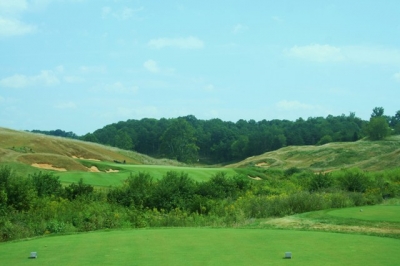 |
| The par three 7th hole is rated the front nine's easiest, yet if you miss the green in any direction, it'll be a very challenging up and down. |
As you might expect, Ireland thinks overcoming the ‘wow’ factor is the hardest part about playing Ballyhack. “Every view from every shot, both from a player’s viewpoint as well as aesthetically speaking, takes your breath away. You’ll need to get past the ‘wow’ factor to plot your best way around, definitely.”
Ireland says the course is especially challenging for those who’ve not played golf in Scotland or Ireland under the same conditions as those at Ballyhack. He calls it the ‘Ballyhack breeze,’ the prevailing wind that George alluded to earlier – which whips out of the southwest. Together with the firm, fast conditions, it takes a different mindset than a typical target-oriented golf layout to challenge successfully.
Ireland is also quick to point out that the Ballyhack layout allows (and rewards) players who use their imaginations and are able to execute shots that take advantage of the conditions present and the contours of the course.
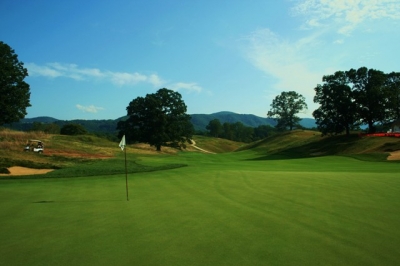 |
| Lester George said the amphitheater 18th green never changed from day one of the planning stage - and from this view, you can see why. |
A good example is the par four sixteenth hole, which measures 491 yards from the back tees. That’s a lot of golf hole for just about everyone, but the wind is usually at your back off the tee – so the hole actually plays much shorter than the listed yardage.
There’s also a lot of room to choose from throughout the course, once you’re familiar with the playing areas. “Though it doesn’t always appear so from the hitting areas, once a player hits their shot, they realize how generous the landing areas really are. The fairways are expansive, up to 120 yards in some cases. The greens are very large as well, providing players the opportunity to hit a lot of greens per round,” Ireland added.
When you see a course of this magnitude, you’re probably thinking they built it to potentially attract ‘big’ events. Not so, according to George and Ireland. Ballyhack will not seek any large scale Tour level events, but the owners also believe it’d be perfect for quality state and regional amateur events such as the Virginia state amateur or Virginia-Carolinas Team Matches – because the design, strategies, character and playing conditions lend themselves well to match-play formats.
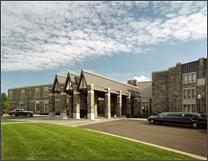 |
| The Inn at Virginia Tech |
It doesn’t matter whether Ballyhack ends up getting a lot of time on TV, anyone who sees it will instantly have it etched in their memories – for its uniqueness, its challenge, its aesthetic qualities and its friendly, relaxingly unhurried atmosphere. After playing there, you’ll become a believer yourself -- that some things are truly just meant to be.
Where we stayed
On our trip to the Roanoke/Blacksburg area, we took advantage of an opportunity to stay at the Inn at Virginia Tech – the university’s very own ‘guest house’ – located right next to the campus and offering 147 guest rooms and suites to those visiting the area.
The Inn is just a short walk to the heart of the university campus, and whether you’re there to relive the old college days, to play golf in the area (it’s about a half hour from Ballyhack) or attend a sporting event, it’s highly recommended that you take in another aspect of the ‘college experience’ and stay at the Inn.
The guest rooms were well accented and roomy, and also featured free wireless internet – very handy for those who need to stay ‘connected’ even away from home. In-room amenities also include beverage stations, cable TV and room service for those desiring a bit of extra convenience.
Dining-in is also recommended at Preston’s restaurant, where we had a chance to sample the breakfast buffet – which includes all your breakfast favorites and even some you might not expect. In addition to the delicious meal, it was great to talk with the restaurant staff, which included students and ‘professionals,’ all enthusiastic about the school.
Another terrific feature at the Inn was the fitness center, which is complimentary to guests and provides yet another way to ‘stay in touch’ with your wellness routine while on the road.
Even though we’re not graduates of Virginia Tech, it was a lot of fun to take in the Hokie spirit at the Inn – which left a very positive impression of the school and its community.
The Inn at Virginia Tech and Skelton Conference Center
901 Prices Fork Road
Blacksburg, VA 24061
Phone: 540-231-8000 or 877-200-3360
Fax: 540-231-0146
Website: http://www.innatvirginiatech.com/
Details:
3609 Pitzer Road
Roanoke, VA 24014-6212
Phone: (540) 427-1395
FAX: (540) 427-1396
Website: http://ballyhackgolfclub.com
Course Designer: Lester George
Course Builder: Bill Kubly/Landscapes Unlimited
Director of Golf Operations: Jonathan Ireland, PGA
Head Golf Professional: Aaron Dooley, PGA
Tees/Yardage (Course slope/ratings were unavailable at time of publication)
Big Lick 7294
Ballyhack 6753
Ridge 6131
Star 5637
Valley 5108
Membership Information:
Local and national memberships are available – check the website listed above.
Real Estate
In addition to a world-class destination golf club, Ballyhack has a very limited number of breathtaking home sites being offered. These custom home sites surround the golf course and offer fabulous views of both the course and the majestic Blue Ridge Mountains that can be seen in every direction. Information regarding opportunities to live at Ballyhack can be found on the Website or by contacting the Club.
| Related Links | Comments on this article? | |
|
Maryland National Golf Club Hollow Creek Golf Club Rocky Gap Resort PB Dye Golf Club in Ijamsville Whiskey Creek Golf Club |
E-mail Jeff Rendall, Editor: jrendall@golftheunitedstates.com |












